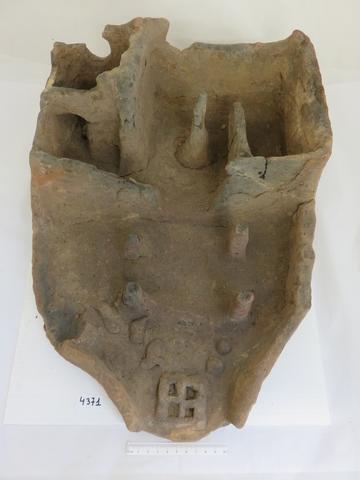Petrie´s soul houses. Provenance: Rifeh. Location: Western Institutions
By Marisol Solchaga
Part of my PhD research is the analysis of pottery offering trays, which appeared in Middle Kingdom cemeteries, with the aim of understanding their archaeological context and function. The case study of Rifeh is of particular importance as a considerable number of these trays were found at that site. These, however, are spread across many different museums after a complicated distribution that I have reconstructed.
Rifeh is located in Middle Egypt and is the place of a series of cemeteries from all periods. A project led by Wolfram Grajetzki and Prof. John Tait aims to collect and sort the material from this site, some of which is of importance not only to my research, but also to Egyptology in general.
In December 1906 Petrie arrived at the site of Gizeh intending to study the early remains of the Pyramids. Three weeks later, alongside a member of his team, Mr Edwin Ward, Petrie travelled 200 miles south to explore the area from Asyut to Sohag and there found the cemetery site of Rifeh. He then returned to Gizeh, leaving Ward in charge of the excavation, discovering the most iconic artefacts for this site: the soul houses.
The team unearthed around 150 pottery models with a spout for libation, models of vegetables, meat and architectonical elements attached. They were located on the surface of shaft tombs with no superstructure. As Petrie states in his report, the reason why they were preserved in Rifeh better than elsewhere is because the graves were made in a growing shoal of gravel, which continued to grow and so gradually buried the models. The pottery trays with architectural elements attracted Petrie´s attention, who coined the term ‘soul houses’ to describe them.
He was not sure whether the objects were for the ba, the spirit of mobility of the deceased or as an offering for ka, the spirit of substance. Hence, he uses the term ‘soul houses’ to avoid being more specific. According to Petrie, these objects were used as a house for the deceased.
The explanation of this definition is exemplified in the July 1907 edition of the Illustrated London News, which was published shortly after the excavation. The article reports the objects as:
“Used on top of tombs to shelter the soul, when it came out of the tomb to search for sustenance. Originally, a mat with a dish of flour was set out on the ground. These elements became an emblem of appeasement or satisfaction, and the figure of it was known as the hieroglyph Hotep. In the pyramids, this was represented by a carving on a stone altar, which was later replaced by a cheap imitation – a pottery tray with models of food. Tanks for water were added later.” (News Illustrated, 1907:48)
From the moment these artefacts were uncovered, after four thousand years in the same place, they left their primary function to enter into the nascent twentieth-century world as Petrie´s soul houses.
Besides designating a name for them, he also dedicated a detailed study in his report of the Rifeh excavations in 1907. Using consecutive letters A to N to classify these objects, A was used for those he considered to be the earliest form and N the most recent. Petrie (1907) argued that the earliest examples contained simple shelters at the back of the tray, whereas the later models were representations of real houses with several rooms, floors, windows and furniture.
As well as giving these objects a name and a typology, Petrie created a distribution list, which listed artefacts from Rifeh, including soul houses, which were sent to different museums around the world. Tombs which contained soul houses are distinguished by the prefix H. For example, in the below there are 2 soul houses listed as being in Cairo, 102 and 129. That means that these tombs were numbered H102 and H129 respectively.
Table 1: List of tomb numbers with soul houses and their locations today |
It is in these institutions where, according to the distribution list, the so-called soul houses from Rifeh are held. The table above comprises soul houses included the distribution list and which appear on Petrie´s report of 1907, objects accounted for in 2019 and soul houses which are not included in the distribution list but are currently in museum collections.
As can be seen in Table 1, the distribution list in many cases does not correspond with what is actually held in the different institutions nowadays. In addition, some soul houses which were not listed are now part of museum collections. Moreover, others which appeared on the list as allocated to a specific institution and are now in other museum’s collection. For example, soul house number 121 appears on the distribution list for Edinburgh, but in reality is held in the Petrie Museum. In another case, soul houses numbers 19 and 10, which were allocated to Rochdale, my research has shown are actually held in Brussels (19) and Boston (10).
The title of this article refers to Petrie’s name for these objects based on his interpretation of what their function was. My mission, through my PhD, is to locate these soul houses, put them into archaeological context and analyse their function in order to return them, if not physically, to where they come from.
Petrie, W. M. F. (1907) Gifeh and Rifeh, London.
Soul Houses, New Illustrated (1907, June 8).
I want to thank the curators of the museums listed in the Distribution list for allowing me to do research in the collections and providing me with the information I needed to conduct my research.

Document which shows the objects from Rifeh sent to Rochadle in 1907. It can be read that 3 soul houses much broken, 1 restored and a tray of offerings are part of the material. Courtesy of the Touchstones Rochdale Museum

Manchester Museum 4371. Photo taken by the author
